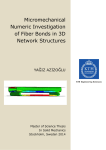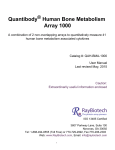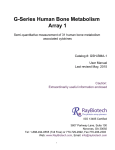Download Manual - RayBiotech, Inc.
Transcript
Quantibody® Human Ig Isotype Array 1 Quantitative measurement of 8 human Immnunoglobulins Catalog #: QAH-ISO-1 User Manual Last revised March, 2015 Caution: Extraordinarily useful information enclosed ISO 13485 Certified 3607 Parkway Lane, Suite 100 Norcross, GA 30092 Tel: 1-888-494-8555 (Toll Free) or 770-729-2992, Fax:770-206-2393 Web: www.RayBiotech.com, Email: [email protected] 1 Table of Contents Section Page # I. Overview 3 II. Introduction 3 III. How It Works 5 IV. Materials Provided 6 V. Storage 6 VI. Additional Materials Required 6 VII. General Considerations A. Sample Preparation B. Handling Glass Slides C. Incubation 7 7 7 7 VIII. Protocol A. Completely Air Dry The Glass Slide B. Prepare Cytokine Standard Dilutions C. Blocking & Incubation D. Incubation with Biotinylated Antibody Cocktail & Wash E. Incubation with Cy3 Equivalent Dye-Streptavidin & Wash F. Fluorescence Detection G. Data Analysis 8 8 8 9 10 10 11 12 IX. Array Map & Standard Curves 13 X. Standard Concentrations 14 XI. Notes Page 15 XII. Q-Analyzer: Data Analysis Software 16 XIII. Troubleshooting Guide 17 XIV. Select Publications 18 XV. Experiment Record Form 19 XVI. How To Choose A Quantibody® 20 Please read the entire manual carefully before starting your experiment 2 I. Overview Cytokines Detected (8) Format IgA, IgD, IgE, IgG1, IgG2, IgG3, IgG4, IgM See Section IX for Array Map One standard glass slide is spotted with 16 wells of identical cytokine antibody arrays. Each antibody is arrayed in quadruplicate. Detection Method Fluorescence. Go to www.RayBiotech.com/Scanners for a list of compatible laser scanners. Sample Volume 50 - 100 µl per array (Sample Dilution: 40,000X - 200,000X) Reproducibility CV <20% Assay Duration 6 hours II. Introduction The human immune system consists of two functional components classified as the innate system (the physical, biochemical and cellular barriers), and the adaptive immune system (including lymphocytes and immunoglobulins). Immunoglobulins are the key elements of the humoral immune response in vertebrate against parasitic invasion. The polypeptide chains of immunoglobulins composed of two identical heavy (H) chains and two identical light (L) chains linked together by inter-chain disulfide bonds. While the amino-terminal portions that exhibits highly variable amino-acid composition are involved in antigen binding, the C terminal constant parts are involved in complement binding, placental passage and binding to cell membranes. Based upon the variation of the constant region of the heavy chain, nine immunoglobulin heavy chain isotypes are found in humans: IgA (with subclasses IgA1 and IgA2), IgD, IgE, IgM, and IgG (with subclasses IgG1, IgG2, IgG3, and IgG4). IgG is the predominant immunoglobulin in the serum (about 12 mg/ml), which accounts for 75% of the total serum antibody of healthy individuals. IgG has a molecular weight of about 150 kDa. Four distinct subgroups of human IgG (IgG1, IgG2, IgG3, and IgG4) were first demonstrated in the 1960's by using polyclonal antisera prepared in animals immunized with human myeloma proteins. Quantitatively, the relative abundance of the four subclasses in adult human serum follows IgG1 > IgG2 > IgG3 = IgG4, which accounts for 6.98, 3.8, 0.56, and 0.56 mg/ml respectively. 3 III. How It Works 4 IV. Materials Provided Catalog # Component Name 1 Slide Box 2 Slide Box* 1 2 1 QAH-ISO-1S Human Ig Isotype Array 1 Glass Slide 2 QA-SDB Quantibody® Sample Diluent 3 AA-WB1-30ML 20X Wash Buffer I 4 AA-WB2-30ML 20X Wash Buffer II 5 QAH-ISO-1-STD Human Ig Isotype Array 1 Lyophilized Standard Mix** 1 Vial 2 Vials 6 QAH-ISO-1B Human Ig Isotype Array 1 Biotinylated Antibody Cocktail 1-25 µl 2 x 1-25 µl 7 QA-CY3E Cy3 equivalent dye-conjugated Streptavidin 5 µl 2 x 5 µl 8 QA-SWD Slide Washer/Dryer 1 x 30 ml Tube 9 QA-ADH Adhesive Film 1 15 ml 2 x 30 ml 3 x 30 ml 30 ml 2 * 4 slide kits are comprised of 2 separate 2 slide kits. ** See Section X for detailed cytokine concentrations after reconstitution. V. Storage Upon receipt, all components should be stored at -20°C. The kit will retain activity for up to 6 months. Once thawed, the glass slide, standard mix, antibody cocktail and dye-conjugated Streptavidin should be kept at -20°C. All other components may be stored at 4°C. The entire kit should be used within 6 months of purchase. VI. Additional Materials Required Benchtop rocker or orbital shaker Laser scanner for fluorescence detection Aluminum foil Distilled water 1.5 ml Polypropylene microcentrifuge tubes 5 VII. General Considerations A. Preparation of Samples Blood samples should be collected by venipuncture. Allow to clot naturally. Undiluted samples may be stored at 2-8°C for up to 72 hours or in -20°C for longer periods. Avoid repeated freezing and thawing. Sample dilution: The suggested dilution for the patient sample is 1:40,000. However, user may decide to use the optimum range for his own sample. Dilute 1ul serum sample in 199ul sample diluent. Gently mix well, and then proceed with another 1:200 dilution by adding 1ul of the diluted sample to 199ul sample diluent. The net dilution is 1:40,000. B. Handling Glass Slides Do not touch the surface of the slides, as the microarray slides are very sensitive. Hold the slides by the edges only. Handle all buffers and slides with powder free gloves. Handle glass slide/s in clean environment. Because there is no barcode on the slide, transcribe the slide serial number from the slide bag to the back of the slide with a permanent marker before discarding the slide bag. Once the slide is disassembled, you might not have enough info to distinguish one slide from the other. C. Incubation Completely cover array area with sample or buffer during incubation. Avoid foaming during incubation steps. Perform all incubation and wash steps under gentle rocking or rotation. Cover the incubation chamber with adhesive film during incubation, particularly when incubation is more than 2 hours or <70 µl of sample or reagent is used. Several incubation steps such as step 6 (blocking), step 7 (sample incubation), step 10 (detection antibody incubation), or step 13 (Cy3 equivalent dyestreptavidin incubation) may be done overnight at 4°C. Please make sure to cover the incubation chamber tightly to prevent evaporation. 6 VIII. Protocol A. Completely Air Dry The Glass Slide 1. Take out the glass slide from the box, and let it equilibrate to room temperature inside the sealed plastic bag for 20-30 minutes. Remove slide from the plastic bag, peel off the cover film, and let it air dry for another 1-2 hours. Incomplete drying of slides before use may cause the formation of "comet tails," thin directional smearing of antibody spots. B. Prepare Cytokine Standard Dilutions There is only one vial of standard provided in the two-slide kit, which is enough for making two standard curves. Reconstitute the lyophilized standard within one hour of usage. If you must use the standard for two different days, store only the Std1 dilution at -80°C. 2. Reconstitute the Cytokine Standard Mix (lyophilized) by adding 500 µl Sample Diluent to the tube. For best recovery, always quick-spin vial prior to opening. Dissolve the powder thoroughly by a gentle mix. Labeled the tube as Std1. 3. Label 6 clean microcentrifuge tubes as Std2 to Std7. Add 200 µl Sample Diluent to each of the tubes. 7 4. Pipette 100 µl Std1 into tube Std2 and mix gently. Perform 5 more serial dilutions by adding 100 µl Std2 to tube Std3 and so on. 5. Add 100 µl Sample Diluent to another tube labeled as CNTRL. Do not add standard cytokines or samples to the CNTRL tube, which will be used as negative control. For best results, include a set of standards in each slide. Since the starting concentration of each cytokine is different, the serial concentrations from Std1 to Std7 for each cytokine are varied which can be found in Section X. C. Blocking & Incubation 6. Add 100 µl Sample Diluent into each well and incubate at room temperature for 30 minutes to block slides. 7. Decant buffer from each well. Add 100 µl standard cytokines or samples to each well. Incubate arrays at room temperature for 1-2 hour. Longer incubation time is preferable for higher signals. This step may be done overnight at 4°C. We recommend using 50 to 100 µl of original or diluted serum, plasma, conditioned media, or other body fluid, or 50-500 µg/ml of protein for cell and tissue lysates. Cover the incubation chamber with adhesive film during incubation, especially if less than 70 ul of sample or reagent is used. 8. Wash: Decant the samples from each well, and wash 5 times (5 min each) with 150 µl of 1X Wash Buffer I at room temperature with gentle shaking. Completely remove wash buffer in each wash step. Dilute 20x Wash Buffer I with H2O. (Optional for Cell and Tissue Lysates) Put the glass slide with frame into a box with 1X Wash Buffer I (cover the whole glass slide and frame with Wash Buffer I), and wash at room temperature with gentle shaking for 20 min. 8 Decant the 1x Wash Buffer I from each well, wash 2 times (5 min each) with 150 µl of 1X Wash Buffer II at room temperature with gentle shaking. Completely remove wash buffer in each wash step. Dilute 20X Wash Buffer II with H2O. Incomplete removal of the wash buffer in each wash step may cause "dark spots," the background signals higher than the spots. D. Incubation with Biotinylated Antibody Cocktail & Wash 9. Reconstitute the detection antibody by adding 1.4 ml of Sample Diluent to the tube. Spin briefly. 10. Add 80 µl of the detection antibody cocktail to each well. Incubate at room temperature for 1-2 hour. Longer incubation time is preferable for higher signals and backgrounds 11. Decant the samples from each well, and wash 5 times (5 mins each) with 150 µl of 1X Wash Buffer I and then 2 times with 150 µl of 1x Wash Buffer II at room temperature with gentle shaking. Completely remove wash buffer in each wash step. E. Incubation with Cy3 Equivalent Dye-Streptavidin & Wash 12. After briefly spinning down, add 1.4 ml of Sample Diluent to Cy3 equivalent dye-conjugated streptavidin tube. Mix gently. 13. Add 80 µl of Cy3 equivalent dye-conjugated streptavidin to each well. Cover the device with aluminum foil to avoid exposure to light or incubate in dark room. Incubate at room temperature for 1 hour. 14. Decant the samples from each well, and wash 5 times (5 mins each) with 150 µl of 1X Wash Buffer I at room temperature with gentle shaking. Completely remove wash buffer in each wash step. 9 F. Fluorescence Detection 15. Disassemble the device by pushing clips outward from the slide side. Carefully remove the slide from the gasket. Be careful not to touch the surface of the array side. 16. Place the slide in the Slide Washer/Dryer (a 4-slide holder/centrifuge tube), add enough 1x Wash Buffer I (about 30 ml) to cover the whole slide, and then gently shake at room temperature for 15 minutes. Decant Wash Buffer I. Wash with 1x Wash Buffer II (about 30 ml) and gently shake at room temperature for 5 minutes. 17. Remove water droplets completely by gently applying suction with a pipette to remove water droplets. Do not touch the array, only the sides. You may dry the glass slide by a compressed N 2 stream. 18. Imaging: The signals can be visualized through use of a laser scanner equipped with a Cy3 wavelength (green channel) such as Axon GenePix. Make sure that the signal from the well containing the highest standard concentration (Std1) receives the highest possible reading, yet remains unsaturated. In case the signal intensity for different cytokine varies greatly in the same array, we recommend using multiple scans, with a higher PMT for low signal cytokines, and a low PMT for high signal cytokines. 10 G. Data Analysis 19. Data extraction can be done using the GAL file that is specific for this array along with the microarray analysis software (GenePix, ScanArray Express, ArrayVision, MicroVigene, etc.). GAL files can be found here: www.RayBiotech.com/Gal-Files.html. Need help analyzing all that data? Copy and paste your data into the QAnalyzer Tool specific for this array, catalog number: QAH-ISO-1-SW. More information can be found in Section XII. 11 IX. Array Map & Standard Curves 12 X. Standard Concentrations After reconstitution, the lyophilized cytokine standard mix contains the following concentrations for each antigen included. 13 Notes: 14 XII. Quantibody® Q-Analyzer The Q-Analyzer is an array specific, Excel-based program. It is much more than a simple calculation macro; it performs sophisticated data analysis (see below for description). The Q-Analyzer Tool specific for this array is catalog number: QAH-ISO-1-SW. Key features: Simplicity: Easy to operate and requires no professional training. With a simple copy and paste process, the cytokine concentration is determined. Outlier Marking & Removing: The software can automatically mark and remove the outlier spots for more accurate data analysis Normalization: The program allows for intra- and inter-slide normalization for large numbers of samples. Two Positive Controls: The program utilizes the two positive controls in each array for normalization. Two Analytical Algorithms: Users can choose either linear regression or log-log algorithms to meet their analytical needs. Two Data Outputs: standard curves and digital concentration. User Intervention: The program allows for user manual handling of outliers and other analytical data. Lower and Upper Limits Determination: The program automatically marks out the values below or above the detection range. Standard Deviation: The program outputs the standard deviations of the quadruplicate spots for data accuracy. Analytical Tips: Q-Analyzer analysis tips are included in the program. 15 XIII. Troubleshooting Guide Problem Weak Signal Cause Recommendation Inadequate detection Increase laser power and PMT parameters Inadequate reagent volumes or improper dilution Check pipettes and ensure correct preparation Short incubation time Increase incubation time or change sample incubation step to overnight Too low protein Lessen dilution or do not dilute sample. concentration in sample Concentrate sample if necessary. Uneven signal Poor standard curve High background Improper storage of kit Store kit as suggested temperature. Don't freeze/thaw the slide. Bubble formed during incubation Decrease amount of rocking/shaking during incubations. check for bubble formation and remove bubbles. Arrays are not completed covered by reagent Completely cover arrays with solution for all required steps. Reagent evaporation Cover the incubation chamber with adhesive film during incubation Cross-contamination from neighboring wells Avoid overflowing wash buffer and other solutions into neighboring wells. Comet tail formation Air dry the slide for at least 1 hour before usage Inadequate standard reconstitution or Improper dilution Reconstitute the lyophilized standard well at the room temperature before making serial dilutions. Check pipettes and ensure proper serial dilutions. Inadequate detection Increase laser power so the highest standard concentration for each cytokine receives the highest possible reading yet remains unsaturated. Use freeze-thawed cytokine standards Always use new cytokine standard vial for new set of experiment. Discard any leftover. Overexposure Lower the PMT or sigmal gain. Dark spots Completely remove wash buffer in each wash step. Insufficient wash Increase wash time and use more wash buffer Dust Work in clean environment Slide is allowed to dry out Don't dry out slides during experiment. 16 XIV. Publications Citing This Product 1. Du Y, Wei X, He Y, Wei G, Hampel H, et al. P2-380: Identification and characterization of human autoantibodies that may be used for the treatment of prion diseases. Alzheimer Dementia. 2008;4(4 Suppl):T484 (Abstract P2-380). Species: Human Sample Type: Plasma 2. Wei X, Roettger Y, Tan B, et al. Human Anti-prion Antibodies Block Prion Peptide Fibril Formation and Neurotoxicity. The Journal of Biological Chemistry 2012;287(16):1285812866. doi:10.1074/jbc.M111.255836. Species: Human Sample Type: Conditioned Media More citations for this product may be available. Contact [email protected]. 17 XV. Experiment Record Form Date:_______________________ File Name:___________________ Laser Power:_________________ PMT:________________________ Well No. Sample Name 1 CNTRL 2 Std7 3 Std6 4 Std5 5 Std4 6 Std3 7 Std2 8 Std1 Dilution factor 9 10 11 12 13 14 15 16 18 XVI. How to Choose a Quantibody® Array? Species-based selection: Human (QAH-) Mouse (QAM-) Rat (QAR-) Bovine (QAB-) Canine (QAC-) Equine (QAE-) Feline (QAF-) Primates (QAN-) Porcine (QAP-) Rabbit (QAL-) Function-based selection: Adhesion Molecule Arrays Angiogenesis Arrays Bone Metabolism Arrays Chemokine Arrays Custom Arrays Cytokine Arrays Growth Factor Arrays IGF Signaling Arrays IL-1 Family Arrays Immune Response Arrays Inflammation Arrays Interleukin Arrays Isotyping Arrays MMP Arrays Obesity Arrays Ophthalmic Arrays Periodontal Disease Arrays Receptor Arrays Th1/Th2/Th17 Arrays Cytokine Number-based selection: Arrays are available in the Quantibody ® platform to detect 440 human, 200 mouse, or 67 rat proteins. GLP-Compliant testing services are also available. To learn more about the Quantibody ® Antibody Array, visit www.RayBiotech.com/Quantibody-Multiplex-Elisa-Array.html Quantibody® is the trademark of RayBiotech, Inc. This product is for research use only. ©2015 RayBiotech, Inc 19



















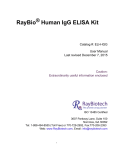
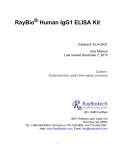
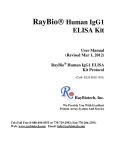
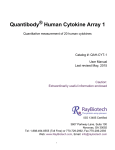

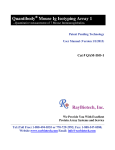
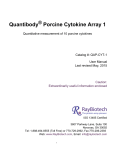
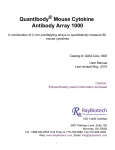
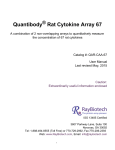
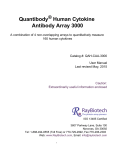

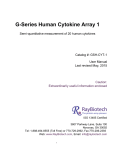
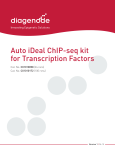
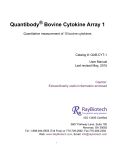

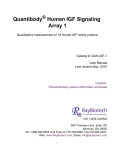

![Progesterone Receptor (PR) [16]](http://vs1.manualzilla.com/store/data/005703733_1-5d4a6a4c070c4aacc906912b3410a27a-150x150.png)
